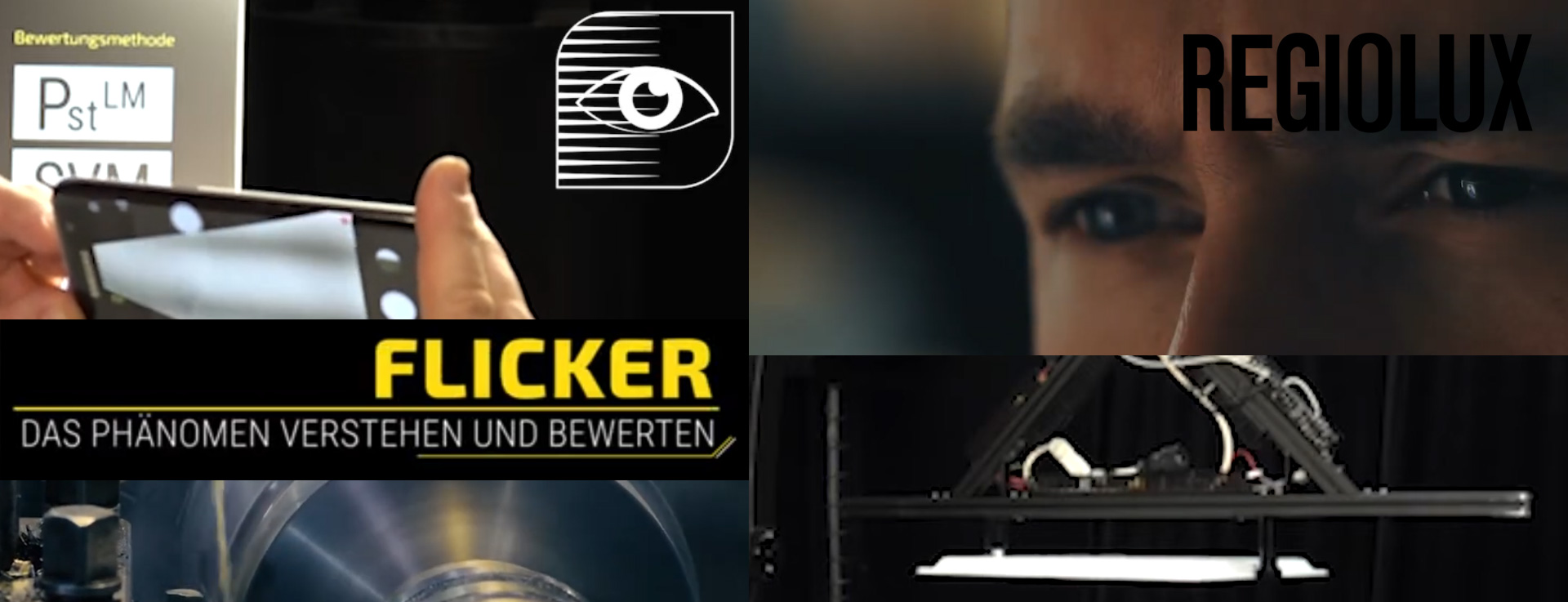Understanding and evaluating the flicker phenomenon
A report by Regiolux
About the project
In general lighting, flicker describes rapid fluctuations in the light intensity of a light source as a result of temporal changes in the current signal applied to the light source. Flicker is not a new phenomenon in principle. The fluctuations, which are largely caused by the sinusoidal 50 Hz mains voltage, have existed since lights were operated with alternating current. While the slow temperature changes of the tungsten filaments in the days of incandescent lamps led to a smoothing of the light signal and the effect was thus minimized, the LED chips used today react extremely quickly to changes in the current signal.
Since the rapid fluctuations in light intensity can result in health and safety impairments, avoiding them by using high-quality LED drivers has become an important quality criterion in the lighting industry.
The term Temporal Light Artifacts (TLA) summarizes the (visual) effects of flickering and stroboscopic effects that are perceptible to humans, depending on the frequency of the fluctuations (see Figure 1).
Figure 1: Visual effects depending on
the fluctuation frequency

Flicker
Flicker is directly visible and can affect the general well-being and performance of the viewer, as well as cause a variety of health problems such as migraines, nausea or increased heart rate. Stroboscopic effects pose a high safety risk, especially in the interaction between humans and machines, e.g. when dealing with rotating machines. [1]
Various measurement methods are used to evaluate these effects. Simple evaluation methods such as the modulation depth (MD) and the flicker index (FI), which do not consider the frequency or waveform of the signal, should only be used as an accompanying measure due to their limitations. [2]
Newer, improved methods such as the PstLM and SVM measurement methods offer more precise evaluations of TLA. Short Term Light Modulation PstLM: Using a fast photodiode detector such as the VL-3702 detector from Gigahertz Optik GmbH in combination with the PFL-200 amplifier [4], the light signal of a lamp can be recorded with a sampling frequency of up to 200 kHz, converted into an electrical signal and then evaluated using software (see Figure 2). [5]
The noticeability threshold is PstLM ≥ 1, i.e. with a determined result of PstLM = 1, 50% of the observers perceive flickering.
Short-term light modulation PstLM::
Using a fast photodiode detector such as the VL-3702 detector from Gigahertz Optik GmbH in combination with the PFL-200 amplifier [4], the light signal from a lamp can be recorded with a sampling frequency of up to 200 kHz and converted into an electrical signal. This is normalized to ensure that the amplitude of the output signal is independent of the absolute light intensity and pre-evaluated using a bandpass filter. The signal is then filtered and weighted using an "eye-brain" model to simulate the frequency-dependent flicker sensitivity of human perception. The PstLM value can then be calculated by examining the frequency distribution (see Figure 2). [5] The noticeability threshold is PstLM ≥ 1, i.e. with a determined result of PstLM = 1, 50% of observers perceive flickering.
Figure 2: PstLM assessment procedure according to EN 61000-3-3 [10]
Stroboscopic Visibility Measure SVM:
Figure 3: Block diagram of SVM measurement method according to [2]
The light signal is recorded analogously to the PstLM method. The signal is converted from the time domain to the frequency domain using Fourier transformation. The frequency components can then be summed according to DIN IEC/TR 63158. Each component is weighted using a sensitivity curve based on human perception. [6] The calculated sum represents the SVM value. Figure 4 shows a comparison of two SVM measurements of different luminaires recorded with the PFL-200 from Gigahertz Optik GmbH. The weighted spectra of the light signals are shown in gray, the noticeability threshold SVM = 1 in yellow.
Abbildung 4: Vergleich von spektralen Messsignalen mit unterschiedlichen SVM-Werten (links: SVM = 1,85; rechts: SVM = 0,005)
While the fluctuations of the right signal are unlikely to be noticed by an observer due to the low SVM value determined, the SVM value of the left signal is well above the noticeable threshold - an observer is likely to perceive flickering. Current limits for PstLM and SVM are proposed in IEEE 1789 and the Ecodesign Regulation (EU) 2019/2020 as follows [1] [7] [8]:
PstLM ≤ 1
SVM ≤ 0,4

Bibliography
[1] „IEEE Recommended Practices for Modulating Current in High-Brightness LEDs for Mitigating Health Risks to Viewers,“ IEEE, 2015.
[2] ZVEI, „Temporal Light Artefacts - TLA; Flicker and Stroboscopic Effect,“ März 2017. [Zugriff am 31 Mai 2024].
[3] Gigahertz-Optik, „VL-3702; Messkopf zur Messung der photopischen Beleuchtungsstärke in Lux,“ GigahertzOptik, 2024. [Zugriff am 31 Mai 2024].
[4] Gigahertz-Optik, „PFL-200; Schneller Flicker Verstärker für Photodioden-Detektoren mit BNC-Anschluss,“ Gigahertz-Optik, 2024. [Zugriff am 31 Mai 2024].
[5] DIN EN 61547 VDE 0875-15-2 Beiblatt 1:2021-03; EMV-Störfestigkeitsanforderungen; Beiblatt 1: Objektives Flickermeter und Störfestigkeitsprüfverfahren gegen Spannungsschwankungen, VDE Verlag, 2021.
[6] DIN IEC/TR 63158:2019-06; Einrichtungen für allgemeine Beleuchtungszwecke - Objektives Prüfverfahren der stroboskopischen Effekte von Beleuchtungseinrichtungen (IEC TR 63158:2018 + COR1:2018), DIN Media, 2019.
[7] E. Union, „VERORDNUNG (EU) 2021/341 DER KOMMISSION zur Änderung der Verordnungen (EU) 2019/424, (EU) 2019/1781, (EU) 2019/2019, (EU) 2019/2020,,“ 23 Februar 2021. [Zugriff am 30 Mai 2024].
[8] E. Union, „VERORDNUNG (EU) 2019/2020 DER KOMMISSION zur Festlegung von Ökodesign-Anforderungen an Lichtquellen und separate Betriebsgeräte gemäß,“ 1 Oktober 2019. [Zugriff am 30 Mai 2024].
[10] A. Mahlkow und I. Rothert, „Vom Flicker zum Wohlfühllicht; Analyse von Lichtartefakten,“ bulletin.ch, 4
November 2020.[Zugriff am 31 Mai 2024]
At a glance
- Evaluation of flicker
- Short Term Light Modulation PstLM
- Comparison of spectral measurement signals with different SVM values